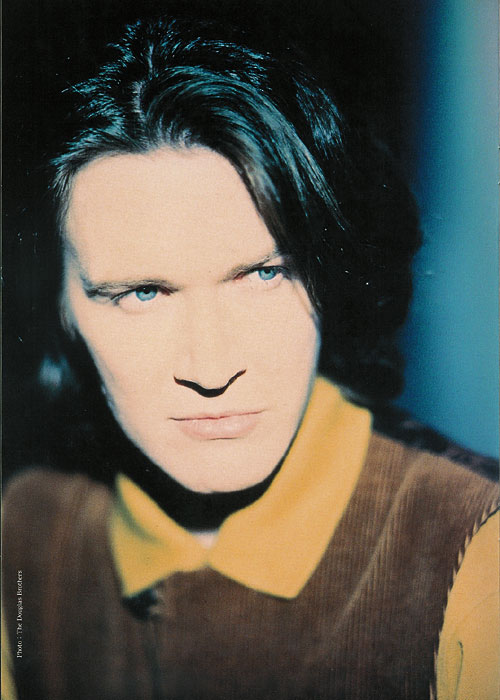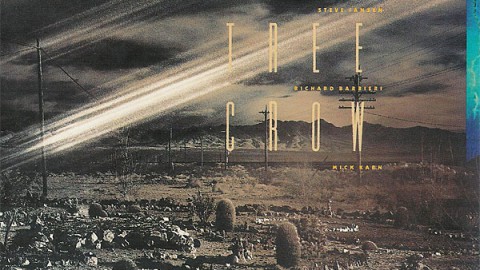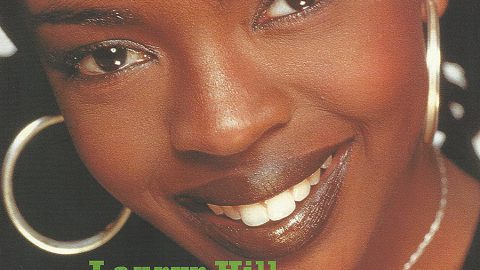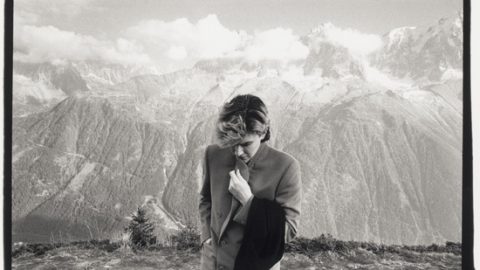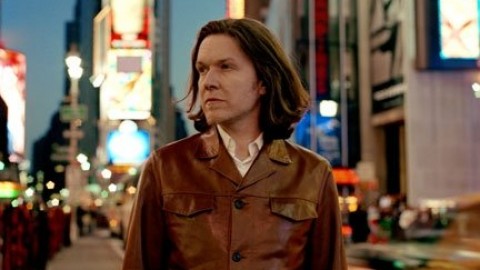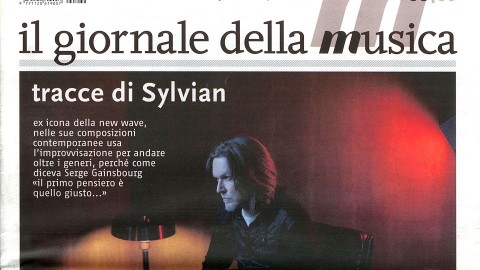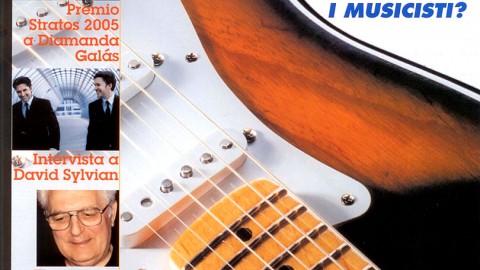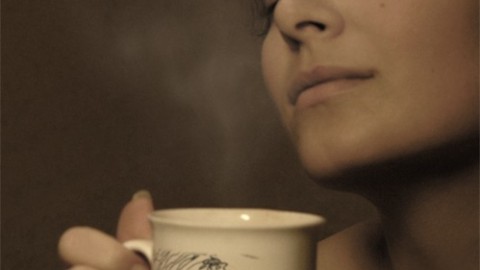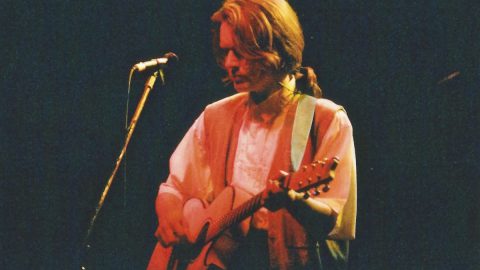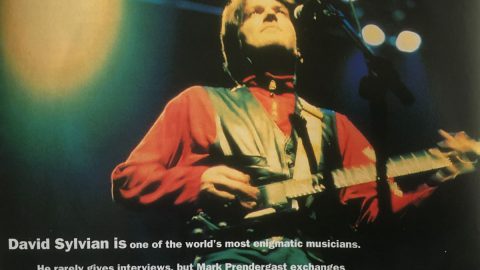
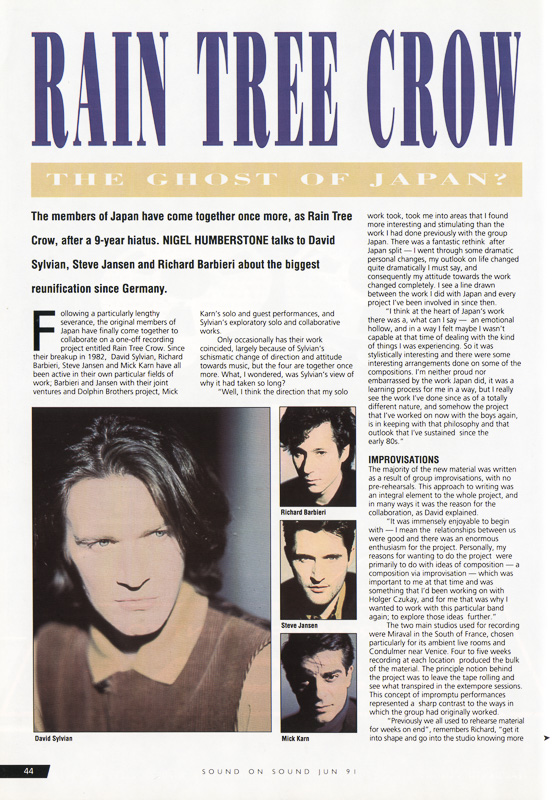

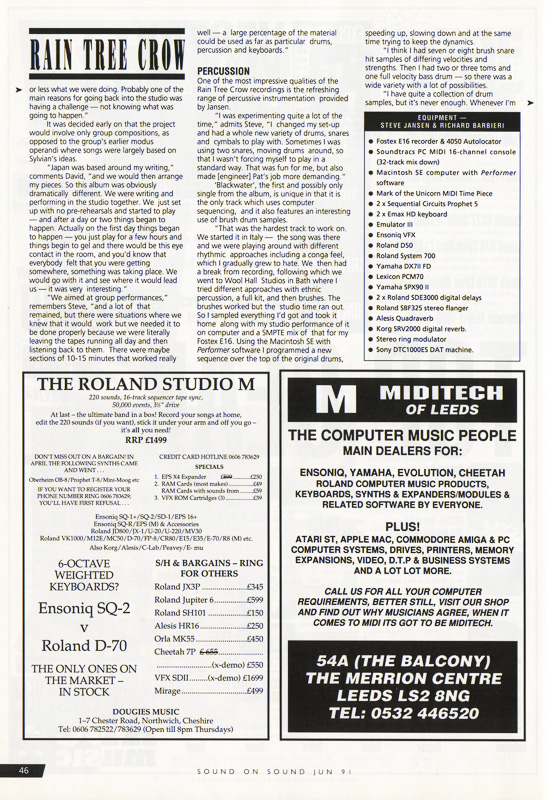

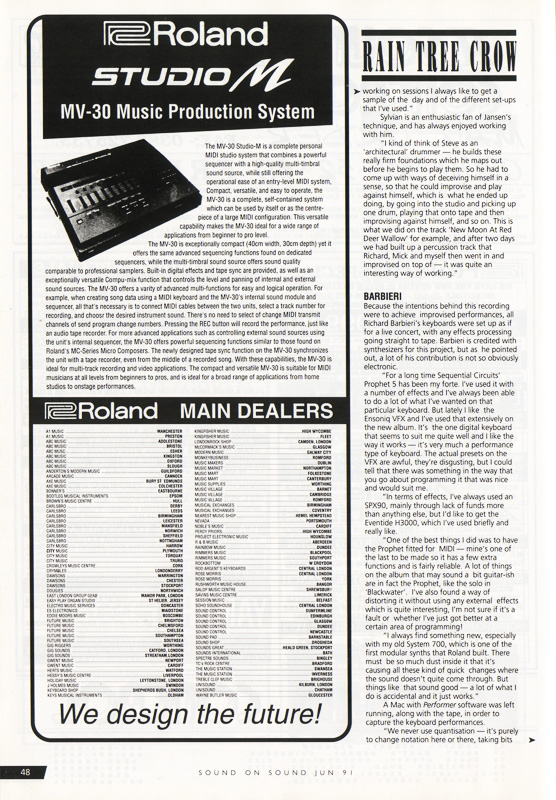

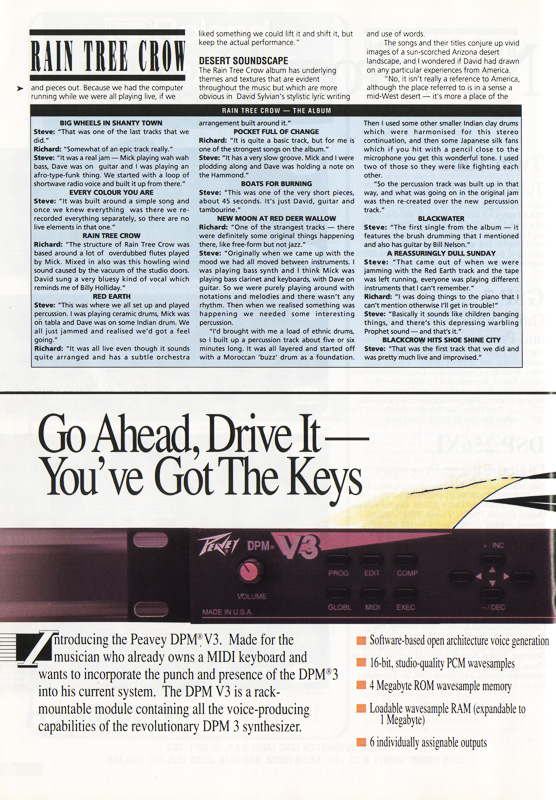

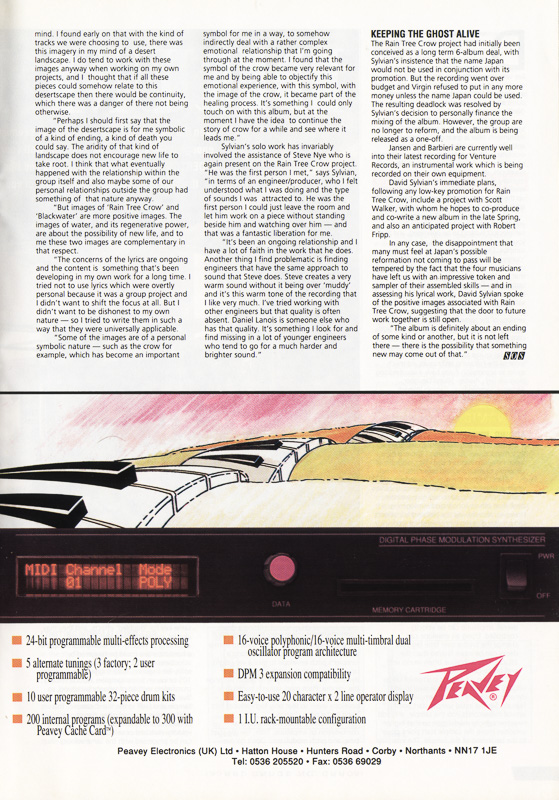
Rain Tree Crow by Nigel Humberstone (SOUND ON SOUND, June ’91)
The members of Japan have come together once more, as Rain Tree Crow, after a 9-year hiatus. NIGEL HUMBERSTONE talks to David Sylvian, Steve Jansen and Richard Barbieri about the biggest reunification since Germany.
Following a particularly lengthy severance, the original members of Japan have finally come together to collaborate on a one-off recording project entitled Rain Tree Crow. Since their breakup in 1982, David Sylvian, Richard Barbieri, Steve Jansen and Mick Karn have all been active in their own particular fields of work; Barbieri and Jansen with their joint ventures and Dolphin Brothers project, Mick Karn’s solo and guest performances, and Sylvian’s exploratory solo and collaborative works.
Only occasionally has their work coincided, largely because of Sylvian’s schismatic change of direction and attitude towards music, but the four are together once more. What, I wondered, was Sylvian’s view of why it had taken so long?
“Well, I think the direction that my solo work took, took me into areas that I found more interesting and stimulating than the work I had done previously with the group Japan. There was a fantastic rethink after Japan split – I went through some dramatic personal changes, my outlook on life changed quite dramatically I must say, and consequently my attitude towards the work changed completely. I see a line drawn between the work I did with Japan and every project I’ve been involved in since then”.
“I think at the heart of Japan’s work there was a, what can I say – an emotional hollow, and in a way I felt maybe I wasn’t capable at that time of dealing with the kind of things I was experiencing. So it was stylistically interesting and there were some interesting arrangements done on some of the compositions. I’m neither proud nor embarrassed by the work Japan did, it was a learning process for me in a way, but I really see the work I’ve done since as of a totally different nature, and somehow the project that I’ve worked on now with the boys again, is in keeping with that philosophy and that outlook that I’ve sustained since the early 80s.”
IMPROVISATIONS
The majority of the new material was written as a result of group improvisations, with no pre-rehearsals. This approach to writing was an integral element to the whole project, and in many ways it was the reason for the collaboration, as David explained.
“It was immensely enjoyable to begin with – I mean the relationships between us were good and there was an enormous enthusiasm for the project. Personally, my reasons for wanting to do the project were primarily to do with ideas of composition – a composition via improvisation – which was important to me at that time and was something that I’d been working on with Holger Czukay, and for me that was why I wanted to work with this particular band again; to explore those ideas further.”
The two main studios used for recording were Miraval in the South of France, chosen particularly for its ambient live rooms and Condulmer near Venice. Four to five weeks recording at each location produced the bulk of the material. The principle notion behind the project was to leave the tape rolling and see what transpired in the extempore sessions.
This concept of impromptu performances represented a sharp contrast to the ways in which the group had originally worked.
“Previously we all used to rehearse material for weeks on end”, remembers Richard, “get it into shape and go into the studio knowing more or less what we were doing. Probably one of the main reasons for going back into the studio was having a challenge – not knowing what was going to happen.”
It was decided early on that the project would involve only group compositions, as opposed to the group’s earlier modus operandi where songs were largely based on Sylvian’s ideas.
“Japan was based around my writing,” comments David, “and we would then arrange my pieces. So this album was obviously dramatically different. We were writing and performing in the studio together. We just set up with no pre-rehearsals and started to play – and after a day or two things began to happen. Actually on the first day things began to happen – you just play for a few hours and things begin to gel and there would be this eye contact in the room, and you’d know that everybody felt that you were getting somewhere, something was taking place. We would go with it and see where it would lead us – it was very interesting.”
“We aimed at group performances, remembers Steve, “and a lot of that remained, but there were situations where we knew that it would work but we needed it to be done properly because we were literally leaving the tapes running all day and then listening back to them. There were maybe well – a large percentage of the material could be used as far as particular drums, percussion and keyboards.”
| EQUIPMENT STEVE JANSEN & RICHARD BARBIERI |
|
PERCUSSION
One of the most impressive qualities of the Rain Tree Crow recordings is the refreshing range of percussive instrumentation provided by Jansen.
“I was experimenting quite a lot of the time,” admits Steve, “I changed my set-up and had a whole new variety of drums, snares and cymbals to play with. Sometimes I was using two snares, moving drums around, so that I wasn’t forcing myself to play in a standard way. That was fun for me, but also made [engineer] Pat’s job more demanding.
‘Blackwater’, the first and possibly only single from the album, is unique in that it is the only track which uses computer sequencing, and it also features an interesting use of brush drum samples.
“That was the hardest track to work on. We started it in Italy – the song was there and we were playing around with different rhythmic approaches including a conga feel, which I gradually grew to hate. We then had a break from recording, following which we went to Wool Hall Studios in Bath where I tried different approaches with ethnic percussion, a full kit, and then brushes. The brushes worked but the studio time ran out. So I sampled everything I’d got and took it home along with my studio performance of it on computer and a SMPTE mix of that for my Foster E16. Using the Macintosh SE with Performer software I programmed a new speeding up, slowing down and at the same time trying to keep the dynamics.
“I think I had seven or eight brush snare hit samples of differing velocities and strengths. Then I had two or three toms and one full velocity bass drum – so there was a wide variety with a lot of possibilities.
“I have quite a collection of drum samples, but it’s never enough. Whenever I’m working on sessions I always like to get a sample of the day and of the different set-ups that I’ve used.”
Sylvian is an enthusiastic fan of Jansen’s technique, and has always enjoyed working with him.
“I kind of think of Steve as an ‘architectural’ drummer – he builds these really firm foundations which he maps out before he begins to play them. So he had to come up with ways of deceiving himself in a sense, so that he could improvise and play against himself, which is what he ended up doing, by going into the studio and picking up one drum, playing that onto tape and then improvising against himself, and so on. This is what we did on the track ‘New Moon At Red Deer Wallow’ for example, and after two days we had built up a percussion track that Richard, Mick and myself then went in and improvised on top of – it was quite an interesting way of working.
BARBIERI
Because the intentions behind this recording were to achieve improvised performances, all Richard Barbieri’s keyboards were set up as if for a live concert, with any effects processing going straight to tape. Barbieri is credited with synthesizers for this project, but as he pointed out, a lot of his contribution is not so obviously electronic.
“For a long time Sequential Circuits’ Prophet 5 has been my forte. I’ve used it with a number of effects and I’ve always been able to do a lot of what I’ve wanted on that particular keyboard. But lately I like the Ensoniq VFX and I’ve used that extensively on the new album. It’s the one digital keyboard that seems to suit me quite well and I like the way it works – it’s very much a performance type of keyboard. The actual presets on the VFX are awful, they’re disgusting, but I could tell that there was something in the way that you go about programming it that was nice and would suit me.
“In terms of effects, I’ve always used an SPX90, mainly through lack of funds more than anything else, but I’d like to get the Eventide H3000, which I’ve used briefly and really like.”
“One of the best things I did was to have the Prophet fitted for MIDI – mine’s one of the last to be made so it has a few extra functions and is fairly reliable. A lot of things on the album that may sound a bit guitar-ish are in fact the Prophet, like the solo in ‘Blackwater’. I’ve also found a way of distorting it without using any external effects which is quite interesting, I’m not sure if it’s a fault or whether I’ve just got better at a certain area of programming!”
“I always find something new, especially with my old System 700, which is one of the first modular synths that Roland built. There must be so much dust inside it that it’s causing all these kind of quick changes where the sound doesn’t quite come through. But things like that sound good – a lot of what I do is accidental and it just works.”
A Mac with Performer software was left running, along with the tape, in order to capture the keyboard performances.
“We never use quantisation – it’s purely to change notation here or there, taking bits and pieces out. Because we had the computer running while we were all playing live, if we liked something we could lift it and shift it, but keep the actual performance.”
DESERT SOUNDSCAPE
The Rain Tree Crow album has underlying themes and textures that are evident throughout the music but which are more obvious in David Sylvian’s stylistic lyric writing and use of words.
The songs and their titles conjure up vivid images of a sun-scorched Arizona desert landscape, and I wondered if David had drawn on any particular experiences from America.
“No, it isn’t really a reference to America, although the place referred to is in a sense a mid-West desert – it’s more a place of the mind. I found early on that with the kind of tracks we were choosing to use, there was this imagery in my mind of a desert landscape. I do tend to work with these images anyway when working on my own projects, and I thought that if all these pieces could somehow relate to this desertscape then there would be continuity, which there was a danger of there not being otherwise.
“Perhaps I should first say that the image of the desertscape is for me symbolic of a kind of ending, a kind of death you could say. The aridity of that kind of landscape does not encourage new life to take root. I think that what eventually happened with the relationship within the group itself and also maybe some of our personal relationships outside the group had something of that nature anyway.
“But images of ‘Rain Tree Crow’ and ‘Blackwater’ are more positive images. The images of water, and its regenerative power, are about the possibility of new life, and to me these two images are complementary in that respect.
“The concerns of the lyrics are ongoing and the content is something that’s been developing in my own work for a long time. I tried not to use lyrics which were overtly personal because it was a group project and I didn’t want to shift the focus at all. But I didn’t want to be dishonest to my own nature – so I tried to write them in such a way that they were universally applicable.
“Some of the images are of a personal symbolic nature – such as the crow for example, which has become an important symbol for me in a way, to somehow indirectly deal with a rather complex emotional relationship that I’m going through at the moment. I found that the symbol of the crow became very relevant for me and by being able to objectify this emotional experience, with this symbol, with the image of the crow, it became part of the healing process. It’s something I could only touch on with this album, but at the moment I have the idea to continue the story of crow for a while and see where it leads me.”
Sylvian’s solo work has invariably involved the assistance of Steve Nye who is again present on the Rain Tree Crow project.
“He was the first person I met,” says Sylvian, “in terms of an engineer/producer, who I felt understood what I was doing and the type of sounds I was attracted to. He was the first person I could just leave the room and let him work on a piece without standing beside him and watching over him – and that was a fantastic liberation for me.”
“It’s been an ongoing relationship and I have a lot of faith in the work that he does. Another thing I find problematic is finding engineers that have the same approach to sound that Steve does. Steve creates a very warm sound without it being over ‘muddy’ and it’s this warm tone of the recording that I like very much. I’ve tried working with other engineers but that quality is often absent. Daniel Lanois is someone else who has that quality. It’s something I look for and find missing in a lot of younger engineers who tend to go for a much harder and brighter sound.
KEEPING THE GHOST ALIVE
The Rain Tree Crow project had initially been conceived as a long term 6-album deal, with Sylvian’s insistence that the name Japan would not be used in conjunction with its promotion. But the recording went over budget and Virgin refused to put in any more money unless the name Japan could be used. The resulting deadlock was resolved by Sylvian’s decision to personally finance the mixing of the album. However, the group are no longer to reform, and the album is being released as a one-off.
Jansen and Barbieri are currently well into their latest recording for Venture Records, an instrumental work which is being recorded on their own equipment.
David Sylvian’s immediate plans, following any low-key promotion for Rain Tree Crow, include a project with Scott Walker, with whom he hopes to co-produce and co-write a new album in the late Spring, and also an anticipated project with Robert Fripp.
In any case, the disappointment that many must feel at Japan’s possible reformation not coming to pass will be tempered by the fact that the four musicians have left us with an impressive token and sampler of their assembled skills – and in assessing his lyrical work, David Sylvian spoke of the positive images associated with Rain Tree Crow, suggesting that the door to future work together is still open.
“The album is definitely about an ending of some kind or another, but it is not left there – there is the possibility that something new may come out of that.”
BIG WHEELS IN SHANTY TOWN
Steve: “That was one of the last tracks that we did.”
Richard: “Somewhat of an epic track really.
Steve: “It was a real jam – Mick playing wah wah bass, Dave was on guitar and I was playing an afro-type-funk thing. We started with a loop of shortwave radio voice and built it up from there.”
EVERY COLOUR YOU ARE
Steve: “It was built around a simple song and once we knew everything was there we re-recorded everything separately, so there are no live elements in that one.”
RAIN TREE CROW
Richard: “The structure of Rain Tree Crow was based around a lot of overdubbed flutes played by Mick. Mixed in also was this howling wind sound caused by the vacuum of the studio doors. David sung a very bluesy kind of vocal which reminds me of Billy Holliday.”
RED EARTH
Steve: “This was where we all set up and played percussion. I was playing ceramic drums, Mick was on tabla and Dave was on some Indian drum. We all just jammed and realised we’d got a feel going.”
Richard: “It was all live even though it sounds quite arranged and has a subtle orchestra arrangement built around it.”
POCKET FULL OF CHANGE
Richard: “It is quite a basic track, but for me is one of the strongest songs on the album.”
Steve: “It has a very slow groove. Mick and I were plodding along and Dave was holding a note on the Hammond.”
BOATS FOR BURNING
Steve: “This was one of the very short pieces, about 45 seconds. It’s just David, guitar and tambourine.”
NEW MOON AT RED DEER WALLOW
Richard: “One of the strangest tracks – there were definitely some original things happening there, like free-form but not jazz.”
Steve: “Originally when we came up with the mood we had all moved between instruments. I was playing bass synth and I think Mick was playing bass clarinet and keyboards, with Dave on guitar. So we were purely playing around with notations and melodies and there wasn’t any rhythm. Then when we realised something was happening we needed some interesting percussion.
“l’d brought with me a load of ethnic drums, so I built up a percussion track about five or six minutes long. It was all layered and started off with a Moroccan ‘buzz’ drum as a foundation.
Then I used some other smaller Indian clay drums which were harmonised for this stereo continuation, and then some Japanese silk fans which if you hit with a pencil close to the microphone you get this wonderful tone. I used two of those so they were like fighting each other.
“So the percussion track was built up in that way, and what was going on in the original jam was then re-created over the new percussion track.”
BLACKWATER
Steve: “The first single from the album – it features the brush drumming that I mentioned and also has guitar by Bill Nelson.”
A REASSURINGLY DULL SUNDAY
Steve: “That came out of when we were jamming with the Red Earth track and the tape was left running, everyone was playing different instruments that I can’t remember.
Richard: “I was doing things to the piano that I can’t mention otherwise I’II get in trouble!”
Steve: “Basically it sounds like children banging things, and there’s this depressing warbling Prophet sound – and that’s it.”
BLACKCROW HITS SHOE SHINE CITY
Steve: “That was the first track that we did and was pretty much live and improvised.”

